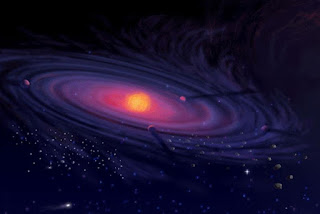The Nebular Hypothesis and Failed Solar System Evolution
Pretty much everyone knows that the origins of the universe, the solar system, life, and humanity are fundamental questions. Believers in atoms-to-atheist evolution find science and logic abhorrent when they support special creation, so they come up with other ideas that are in keeping with materialism.
There is no uniformity among scientists about the origin of the solar system, and there are several speculations that have their own adherents. The nebular hypothesis is the prize pig at the fair, the best of the worst.
 |
| Artists concept of a protoplanetary disk at NASA |
According to the eye-witness account in Genesis, God created the earth on Day 1, and the sun and moon on the Fourth Day, most likely along with the planets. However, evolutionists reject a Creator a priori, so need to come up with another explanation.The leading candidate is called the nebular hypothesis. This proposes that the sun, the earth and the rest of the solar system formed from a nebula, or cloud of dust and gas. The best known pioneer of this was French atheistic mathematician Pierre-Simon Laplace (1749–1827). However, despite the dogmatic support by evolutionary astronomers, it has a number of huge problems.
To read about its problems, spin over to "Solar system origin: Nebular hypothesis."